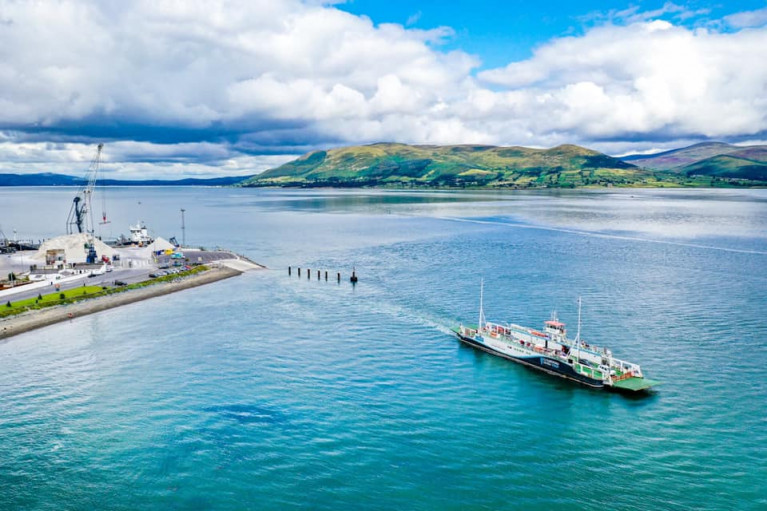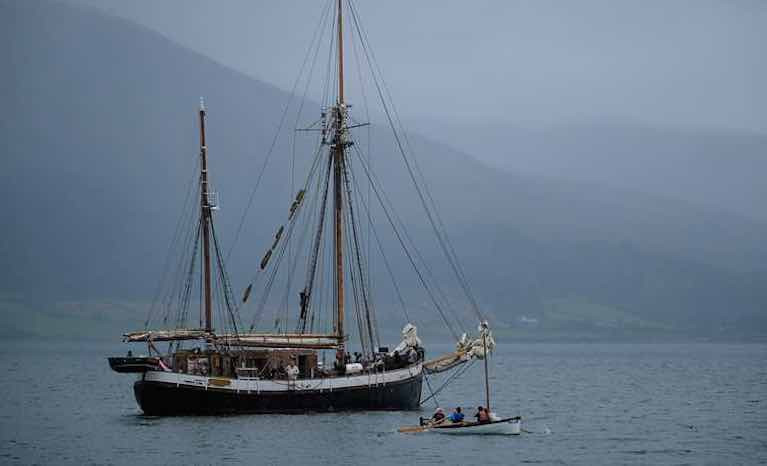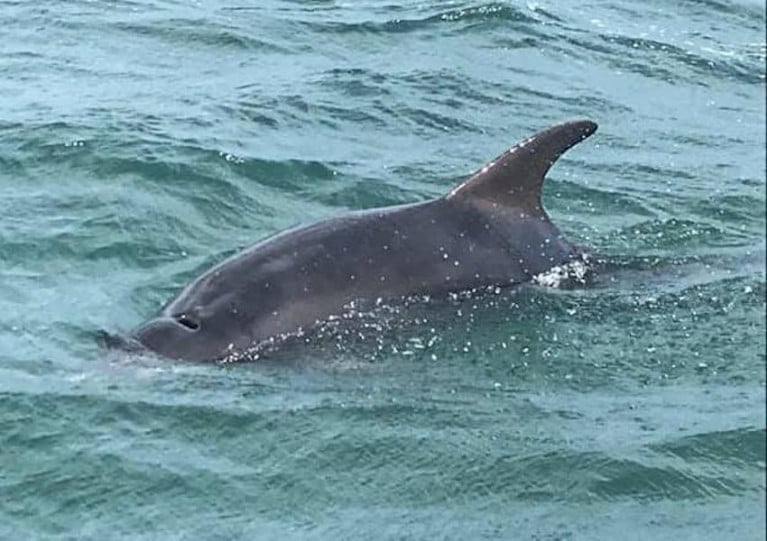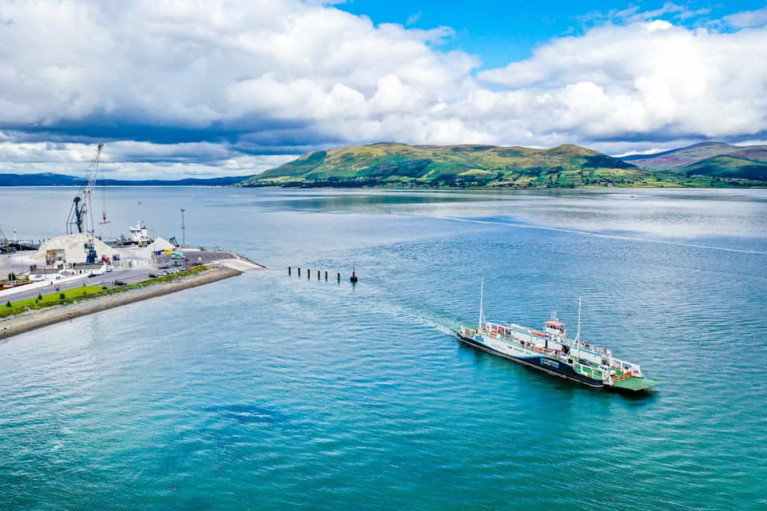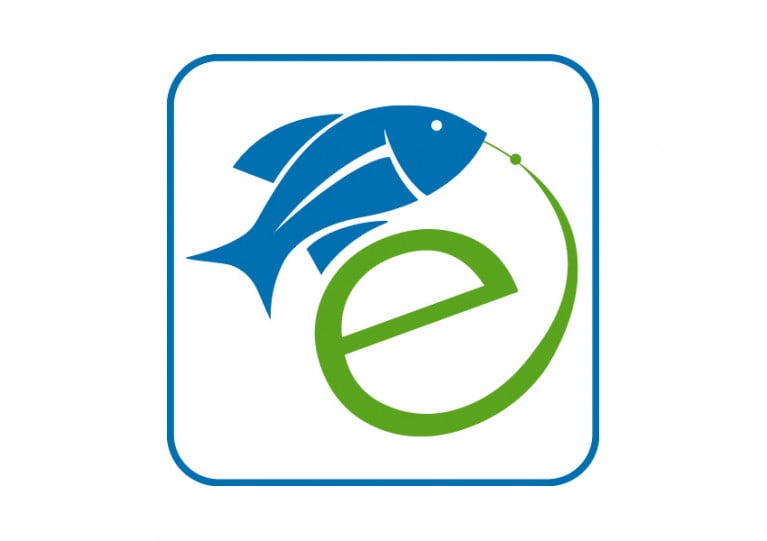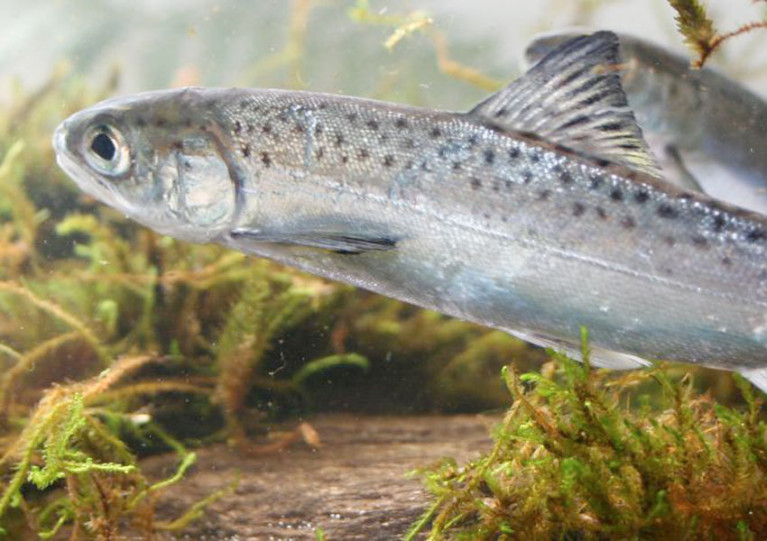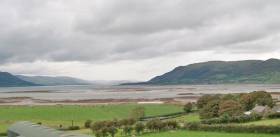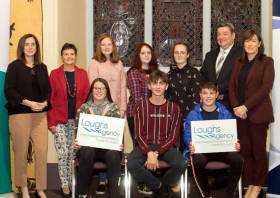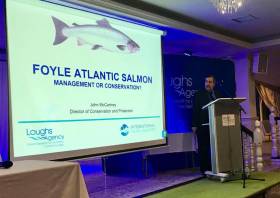Displaying items by tag: Carlingford Lough
Concern for Carlingford’s Resident Dolphin Prompts Investigation After Photos Show Cuts on Its Back
Photos that emerged last month of cuts on the back of Carlingford Lough’s resident dolphin have prompted an investigation, as Independent.ie reports.
Finn the dolphin has become a popular sight off Carlingford and Greenore on Co Louth’s Cooley Peninsula since taking residence in the area more than a year ago.
But concerns for his welfare were raised last month after photos surfaced on the Facebook page for Carlingford Lough and The Cooley Peninsula showing what appeared to be a deep gash on his back below his dorsal fin.
While more recent images of the dolphin show that his wounds are healing, the general public have been urged to keep their distance from the animal.
A spokesperson for the National Parks and Wildlife Service (NPWS) said: “We have not had a chance to fully investigate the reported injuries.
“However, we are aware, as is the Department of Agriculture, Food and the Marine, An Garda Síochána and Louth County Council and an investigation is ongoing.”
The Irish Whale and Dolphin Group’s Pádraig Whooley told Echo Live that curious dolphin-watchers should “stay out of the water and enjoy the spectacle from the shore”.
He added: “The more people engage with this animal, the more people turn him into a local pet [and] the more we are encouraging this aberrant behaviour. It is not natural for a…dolphin to seek out human company.”
Ferry Service on Carlingford Lough to Re-Commence
The coastal ferry service across Carlingford Lough is set to recommence next weekend with the easing of lockdown.
As The Irish News reports, the service, between Greenore in Co.Louth and Greencastle in Co.Down, has not been operational since last March.
Since its launch, the service has been a valuable transport link between the Republic and the north, for commuters and the tourism industry.
Operated by Frazer Ferries Group the company's second cross-border service, the Lough Foyle Ferry, which operates between Greencastle in Co Donegal and Magilligan Point in Derry, is expected to reopen later this month.
Commercial director Irene Hamilton,, said: "We’re absolutely delighted to be opening our service on Carlingford Lough.
More on this development here.
It's 7000 km from the Caribbean island of Grenada to London and somewhat farther if you travel via Den Helder in the Netherlands, Carlingford Lough, the County Down village of Killowen and Bangor in North Wales. And this is how the Chocolate Maker NearyNógs on the edge of the Mourne Mountains forged close ties with Fortnum & Mason of Piccadilly in London, one of the oldest and most luxurious department stores on the planet, to help produce a 99% emission-free sailboat chocolate.
It is thus named because to transport the 25kg blocks of chocolate in a sustainable way as possible, the company looked back to its early 18th century roots and combined some old methods with modern green thinking to enable the 99% emission-free chocolate to be carried that 7,000 km. The chocolate's epic journey begins in the Grenada Chocolate Company's solar-powered factor in the West Indies, where the Trinitario cocoa beans are processed using zero emissions.
 The 30-metre engineless brigantine, the Tres Hombres Photo: courtesy Fair transport
The 30-metre engineless brigantine, the Tres Hombres Photo: courtesy Fair transport
So the first stage across the Atlantic used a 30m engineless brigantine, the Tres Hombres to carry the 350kg of chocolate, in 25kg blocks The ship is owned by Fair Transport. This company carries sustainable and organic cargo between South, Central and North America and Europe. Tres Hombres has become a shining example of the existing possibilities for alternative shipping methods, and she is the ambassador for sail-powered cargo shipping worldwide. Its destination was Den Helder in the Netherlands from where the chocolate began its second voyage on the T/S Britta, with Silvery Light Sailing under Capt Chris Wren, to Carlingford Lough on the east coast of Ireland where it moored close to Killowen on the northern shore.
But that was only part of the story. How to get the chocolate to NearyNógs? Now a team of volunteers heeded the call to transport the chocolate to the Neary family factory. The name NearyNógs comes from children's stories written by Johnnie Neary. Neary is the family name, and Nógs comes from the Irish Gaelic word Tír na nÓg, which means the land of the youth. This passionate team of volunteers used a Boyne Currachs Heritage Group's traditional open-ended clinker-built Drontheim rowing boat. After several trips ashore with the 48 boxes of chocolate, it was a bumpy 9 km by horse and cart to NearyNógs. There the chocolate was broken down into slates, tempered and packaged in recyclable, biodegradable packaging before the final leg of its adventure to Piccadilly.
 The Danish built ketch the Klevia Photo: courtesy Anglesey Traditional Sail
The Danish built ketch the Klevia Photo: courtesy Anglesey Traditional Sail
 The crew of the TS Britta
The crew of the TS Britta
That final leg began with return horse and cart, and Drontheim trips to another boat, the Danish built ketch the Klevia skippered by Scott Metcalf, which transported the cargo to Port Penrhyn, in Bangor, North Wales. And to complete the virtual emission-free the final leg of this sustainable journey was entirely on land, using Fortnum & Mason zero-emission electric vans to Piccadilly.
 The rowers (and the ship's dog) get ready to deliver another load of Chocolate slabs bound for NearyNógs Photo: Columba O’Hare
The rowers (and the ship's dog) get ready to deliver another load of Chocolate slabs bound for NearyNógs Photo: Columba O’Hare
The mission was made possible with the help of the local charity Silvery Light Sailing and a hard-working rowing crew at Killowen. Silvery Light Chairman Gerry Brennan was delighted to help in the arrangements. "As a Newry based sailing charity, we were pleased to be asked help local Mournes business NearyNógs organise the emission-free transportation of their chocolate using traditional sailing ships. Being a part of the story of the journey from the Caribbean to the shelves of Piccadilly is beyond our normal outreach. Still, it was great to help promote the maritime potential and scenic beauty of Carlingford Lough and the Mournes."
 Shane Neary, (right) of NearyNógs chats to Gerry Brennan, Silvery Light Sailing Photo: Columba O'Hare
Shane Neary, (right) of NearyNógs chats to Gerry Brennan, Silvery Light Sailing Photo: Columba O'Hare
Ireland’s Newest Resident Dolphin Gets A Name
Ireland has a new resident dolphin, as a solitary bottlenose seems to have made its home in Carlingford Lough — and locals have voted to name it ‘Finn’.
Nearly 3,000 people took part in the Facebook poll in which Finn (the Anglicisation of Fionn) won out over ‘Bobby’ in a landslide.
“As we don't know if the dolphin is male or female, Finn works well as it is a popular name for both boys and girls,” the Carlingford Lough and the Cooley Peninsula Facebook page said.
“But if we can call our famous legend Finn or Fionn, we are sure the dolphin won’t mind.”
Carlingford dolphin this evening @CarlingfordIRE @DundalksNews pic.twitter.com/uW99G5EqE3
— peter noone (@peterno53001163) July 17, 2020
The Dundalk Democrat reports that Finn has been recently sighted ‘belly flopping’ near the port of Greenore — but marine wildlife experts warn that this may be a sign of distress.
Particularly in light of reports that a snorkeller was seen swimming close to the dolphin, all water users are to be reminded that it is a wild animal and advised to keep their distance.
Rare Opportunity As Ferry 'Cruises' from Carlingford Lough Out to Haulbowline Lighthouse
In an effort to restore even a hint of tourism activity while the Covid-19 restrictions are gradually eased across Ireland, Carlingford Lough Ferry is launching special 'Lighthouse' cruises out to entrance of the scenic lough, writes Jehan Ashmore
The car-ferry Frazer Aisling Gabrielle had been operating the 15 minute cross border Co.Louth (Greenore)/Down (Greencastle) service but due to the escalating Covid19 situation in March, sailings were suspended until further notice.
Operator, Frazer Ferries hope to resume the service in the summer. In the meantime, Frazer Aisling Gabrielle is instead to offer ‘walk on’ passenger cruises onboard the 45m long ferry. The cruises departing from Greenore terminal in Co. Louth is to take place on Saturday, 20 June.
These special and rare 1 hour cruises will involve the ferry been within 400m of the impressive Haulbowline Lighthouse. (See Shine a Light for Healthcare Heroes) The structure to aid mariners jutts dramatically out of the sea and marks the entrance to the stunning scenery of Carlingford Lough.
Those intending taking a cruise are advised to book as soon as possible, due to demand noting passenger numbers are strictly limited in line with the current public safety guidelines.
Onboard will be a fascinating audio tour that will offer insights into glacial fjord with panoramic views sweepong between the Cooley peninsula and as they say the Mourne Mountains that sweep down to the sea!
The Lighthouse themed cruises are especially designed to allow guests to travel in safety and comfort on board the 45m long ferry which with the abscence of cars will provide platforms to take in the views. In order to do, safe social distancing and standing areas will be clearly marked on the upper and lower decks.
In light of current Covid Safety guidelines and for passengers safety, Frazer Ferries request those with families of young children, book tickets for the lower viewing deck area which offers greater space and allows for additional movement, whilst adhering to the required social distancing during the cruise.
According to the operator this Friday afternoon, there are still some tickets available HERE for the cruises. Scroll down the page for additional information on parking in Greenore.
The first sailing on Saturday, 20 June is at 11.30 returning at 1pm and the second sailing is at 2.30 returning at 4pm.
Sailing time is approx 70 mins and the rest of time allows for boarding - departure - arrival and disembarkation.
Whatever cruise is booked, it is strongly advisable to arrive at the terminal 20 minutes prior to the departure for check-in.
Loughs Agency eLicence Portal Now Back Online
The Loughs Agency’s elicence website is now back online and anglers can purchase licences for the Foyle and Carlingford areas.
Anglers are individually responsible for compliance with their government’s advice and guidance. Anglers should keep up to date with the latest advice from the Public Health Agency (PHA) in Northern Ireland and the Health Service Executive (HSE) in Ireland.
Loughs Agency offices remain closed and the normal licence distributor network is also still under lockdown conditions. Therefore, anyone wishing to purchase a licence should do so through the elicence website.
For anglers requesting carcass tags when they purchase a licence online, these will be posted to your address. Anglers should take this into account when purchasing.
For anglers purchasing a Loughs Agency endorsement licence, please ensure you have already purchased a full season licence or concession licence from DAERA or a full season or district licence from Inland Fisheries Ireland (IFI). Loughs Agency carryout checks with our colleagues in DAERA and IFI to validate licence purchases.
If you require a Loughs Agency permit for Foyle, Finn or Greenbraes, please contact the Loughs Agency on +44 (0) 2871 342100 (Mon-Fri 9am-5pm).
Illegal fishing or pollution concerns can be reported through the Loughs Agency’s Waterwatch reporting tool online or through the 24-hour response line on +44 (0) 2871 342100.
If you require any further assistance, call the Loughs Agency at the above number during normal weekday office hours or email [email protected]
NI Primary School Pupils Become ‘Salmon Ambassadors’ For Loughs Agency
Last week the Loughs Agency visited local primary schools in the Foyle and Carlingford areas as part of the Salmon Ambassadors programme.
The programme, which forms part of the legacy of 2019’s International Year of the Salmon, will see the agency working with eight schools (six in Foyle and two in the Carlingford catchmen) to connect pupils with their local river habitats, and use the lifecycle of the salmon to teach them about the broader themes of biodiversity and ecology.
Loughs Agency education officer Michael Cosgrove said: “Through the Salmon Ambassadors we hope to create an informed generation that will value salmon as they should be valued and most importantly, value the environment we share with the ‘King of the Fish’.”
In their journey to becoming a Salmon Ambassador, pupils will learn about issues effecting the Atlantic salmon from local to global level and reflect upon how modern lifestyles have an impact on local wildlife.
Through a range of activities in class and on the banks of local rivers, pupils will be encouraged to take ownership of wild places and wild things so that they can be better conserved for future generations.
Allan Bogle, community engagement officer, said: “Wach school will also look after around 100 salmonid eggs until they hatch. This a participative education programme which is really hands-on so that each pupil can connect with the salmon and their local river.”
Over the next few months, 163 pupils will undertake a range of activities as they research the migration routes, threats and life cycle of the salmon, before presenting their findings and results at a salmon conference in June.
Maritime Heritage Seminars In Foyle & Carlingford This Month
The Loughs Agency has organised two morning seminars around the theme of maritime heritage in the Foyle and Carlingford areas later this month.
The first will take place at Greencastle Golf Club next Friday 22 November from 9.30am to 12.30pm, while Carlingford Marina will host its seminar the following Friday 29 November at the same times.
Both events will include contributions from Patrick Fitzgerald, a professional historian with a long career in researching genealogy and uncovering the story of migration through the centuries, who will take attendees on a journey of migration through the Foyle and Carlingford loughs.
The Greencastle seminar will also hear from Gerald Crawford, former secretary of the Foyle Fisheries Commission, who will tell the story of commercial salmon fishing across two decades Fishing for Salmon in the Foyle.
Retired mariner Seamus Bovaird will be presenting on paddle steamers on Lough Foyle, while Edward Montgomery, secretary of The Honourable The Irish Society, will speak about the society and the Foyle fisheries, and Wes Forsythe, a career archaeologist with an interest in the Foyle area, will presenting on ;Salt and the Sea;.
In Carlingford, Brendan McSherry, Louth County Council’s heritage officer with a passionate awareness of Carlingford Lough, its shores, hinterland and communities, will present on Carlingford Lough, a barrier or a highway?
Kirstin Lemon, geologist by profession with a broader intent to inform communities about their geology and the influence on their culture, will speak about ‘Mountains, Myths and Maritime: a UNESCO Global Geopark in Mourne Gullion Strangford’.
Finally, Liam Campbell, a researcher with an intense interest in exploring the development of cultures within distinct catchments, will present on the ‘Culture of the Catchment – Source to Sea’.
Admission is free free of charge for both events, however tickets must be obtained through Eventbrite to ensure a place at the Foyle and Carlingford seminars respectively.
In other heritage news, the Department of Culture, Heritage and the Gaeltacht has published its report on the public and sectoral meetings held earlier this year on Heritage Ireland 2030, Ireland’s national heritage plan.
Among the issues raised at the sessions in Kilkenny and Galway in February were a lack of joined-up thinking across Government departments with relation to heritage issues, and a recognition of the need to understand heritage in a holistic sense encompassing everything from regional traditions to built heritage and wildlife.
Loughs Agency Celebrates Graduation Of ‘Carlingford Ambassadors’
Earlier this month, 19 young people graduated on the Loughs Agency’s Carlingford Ambassador Programme, an expansion of its successful Foyle Ambassadors scheme.
Supported through funding from the Department of Foreign Affairs and Trade in Ireland, in partnership with Co-operation Ireland, the Carlingford Ambassadors programme is designed to discover the social, economic and environmental importance of the Carlingford Lough catchment, from source to sea.
At the same time, it provides young people with opportunities to engage and build relationships across the region and political divide.
This was done through a range of adventure activities such as fishing and canoeing and as well as environmental projects including clean-ups, shore surveys and personal development sessions.
Shanna Rice, co-ordinator of the programme at the Loughs Agency, said: “During the summer these 19 young people truly became ambassadors of Carlingford, recognising its importance as a natural resource.
“Ambassadors not only built lasting connections with the catchment, they also developed lasting friendships with each other. The experiences they have gained will provide them with skills for life through fun, friendship and adventure.”
Loughs Agency designated officer Sharon McMahon added: “The Ambassadors programme encourages young people to get involved in the conservation and protection of the natural environment, and as the decision makers of the future and future custodians of the natural environment, it is extremely important that they understand the issues effecting this valuable resource today.
“The programme encourages young people to look after their communities, their relationships with their fellow citizens and the natural environment. It provides opportunities for them to enjoy and understand the recreational facility that the great outdoors provides, so that future generations may also enjoy it.
“And just maybe, due to the intervention of young people such as the Foyle Ambassadors, we can make a lasting difference on this wonderful resource to help make it better, more resilient and sustainable.”
Since 2014, nearly 200 young people between the ages of 13 and 17 have participated in this programme in the Foyle and Carlingford areas. And the Loughs Agency says it is keen to continue delivering the programme .
Peter Sheridan, chief executive of Co-operation Ireland, said its involvement in the programme “is a great source of pride for the organisation and we were delighted to be able to support its expansion in 2019 into Carlingford Lough”.
He continued: “I am confident the success we have seen with the Foyle Ambassadors programme over the last five years will be repeated in Carlingford Lough and look forward to continuing our partnership with the Loughs Agency.”
The Ambassador programme has the potential to reach many more young people throughout the Foyle and Carlingford areas, the Loughs Agency says. If you are interested in the programme, register your interest via email to [email protected]
Collective Work Needed To Arrest Decline Of Salmon In Foyle & Carlingford, Conference Hears
Collective work between scientists and the angling community for the survival of salmon in the cross-border catchments of Foyle and Carlingford was to the fore at the recent conference in Omagh hosted by the Loughs Agency.
Stark warnings over the decline of the species were heard along with presentations from the likes of Dr Diego Del Villar, who discussed the new SeaMonitor project that is currently studying the seas around Ireland, Northern Ireland and western Scotland, and will in time help produce a salmon management plan for the River Foyle.
The Loughs Agency says it will soon launch a public consultation to gauge the views of the public in managing the salmon fishery.
John McCartney, Loughs Agency director of conservation and protection, said: “We value the input and opinion of the public when reviewing our salmon management programme. I would encourage everyone take time to consider and respond to the questions.”


























